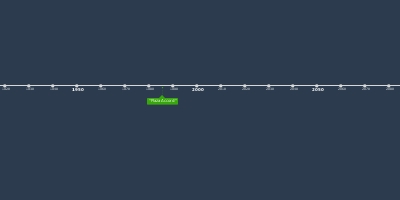1 ene 1991 año - Bubble Burst
Descripción:
Driven by speculative mania, Japan's Nikkei Stock Market Index hit a milestone of 38,916 on 29 December 1989, accounting for more than one-third of the world's stock market capitalization. Simultaneously, the nationwide land price reached 2000 trillion, four times as much as America's national land price. At the beginning of the bubble, the thirty-year-long rapid economic growth gave Japanese people an illusion that Tokyo's asset price will never drop, and it will not take long for Japan to surpass the US to become the strongest country in the world. People maniacally invested tens of million Yen on housings, the price of Ginza's office buildings could double within one day, nobody wanted to miss the perfect chance of making money. As a result, soaring prices attracted more and more people to invest money. However, people did not realize that Japan's urbanization has reached 77.4%, and the aging population started to emerge. The slump on asset prices will be the inevitable result when the population and urbanization bonuses disappear. The years of the economic bubble was like a big and expensive party to Japan. The frugality of the postwar era and the success of the manufacturing industry created extravagance and conspicuous consumption: Housewives were sipping coffee that worth $500; night clubs gave away golden watches as gifts; aristocratic sports like golf started becoming versatile among civilians; people spending million Yens on learning English; traveling abroad to purchase Louis Vuitton and Gucci handbags, while none of them would believe that the economic empire will collapse within one night.By 1989, as Japanese officials became increasingly aware of the country's growing asset bubble, the Bank of Japan decided to increase its interest rate to cool the stock market down. However, the increase in interest rate directly led to the balloon burst in 1990. The stock market plummeted, lost more than 2 trillion dollars in value by the end of 1990, languished about 40% below the peak. The housing market also experienced a vertiginous drop; the asset price shrunk from 2.3 million Yen to 0.7 million Yen per square meter within only five years. By 2004, residential real estate in Tokyo was only worth 10% of its late 1980s peak, and the most expensive land in Tokyo's Ginza business district had fallen back to just 1% of its 1989 level in the same year. Along with the collapse of the asset price, people's wealth kept shrinking, the loss reached 15 million Yen, which equals the sum of three years' GDP. The bubble struck Japan's economy, it then entered the infamous "Lost Twenty Years," when Japan's economy halted for twenty years. Although the Plaza Accord is the flashpoint of Japan's economic crash and limited the manufacturing industries' developments, the Japanese government's misjudgment of Japan's housing and stock markets ultimately caused the bubble. It burned Japan's past economic successes into ashes. People born in the 1970s grew up with dramatic social changes, and people who were born after also experienced heavy social stresses. Frustration and disappointment began to spread among young people, as a result, in today's Japan, there is a considerable amount of people called "hikikomori (ひきこもり)," who isolate themselves from society and financially dependent on their parents, and the arsonist Aoba Shinji is considered one of them.
Añadido al timeline:
fecha:
1 ene 1991 año
Ahora mismo
~ 34 years ago
